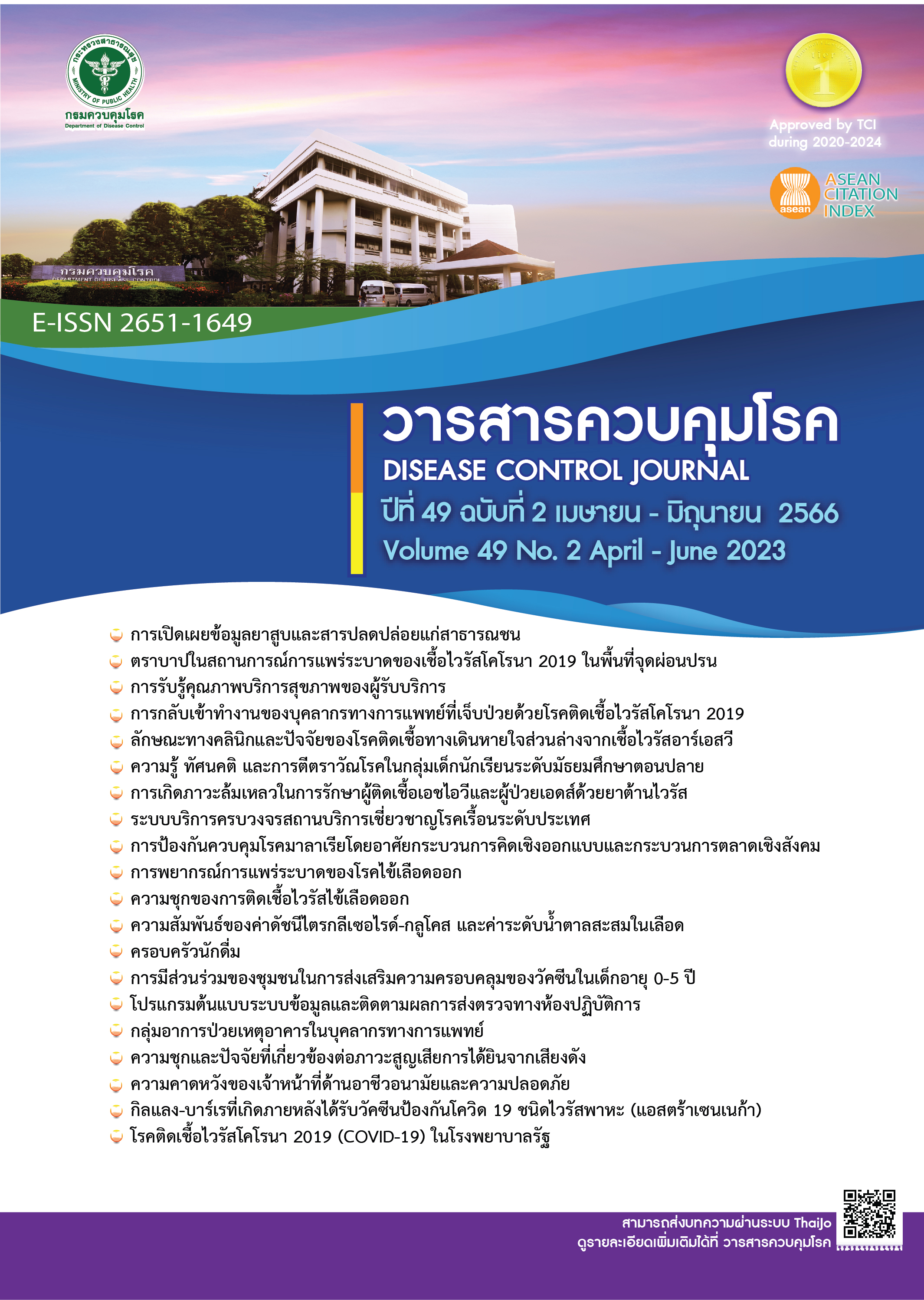Prevalence and factors associated with sick building syndrome among healthcare workers
DOI:
https://doi.org/10.14456/dcj.2023.36Keywords:
sick building syndrome, healthcare worker, indoor air qualityAbstract
Sick building syndrome (SBS) is a syndrome that causes negative impact on health, decreases productivity, and increases absenteeism. Typically, the syndrome appears only when you spend time in the building; however, no specific cause or illness can be identified. Healthcare workers have an intensive workload and a different work environment compared to other occupations, and those unique work characteristics may cause sick building syndrome. The objectives of this research are to study the prevalence and factors associated with sick building syndrome in 10 government hospitals in Bangkok, which are under Public Health Regions 5 and 6. The study was a cross-sectional descriptive study. The data were collected from December 2021 to January 2022 by measuring air quality inside 53 hospital rooms and self-administered questionnaires were utilized to obtain the data from 303 healthcare workers who worked in those hospital rooms in which air quality was being measured. The data were analyzed by multivariate, multilevel logistic regression. The results indicated that the prevalence of sick building syndrome was 22.1%, and the most common symptom was neurological symptom (52.2%). Indoor air quality measurements indicated an average temperature of 25.6 °c, average relative humidity of 61.8 %RH, median airflow 0.18m/s, average carbon monoxide concentration 1.2 ppm, average carbon dioxide concentration 694.9 ppm, and average bacteria 296.8 CFU/m3. Identified factors associated with sick building syndrome were using computer for work-related purposes (mOR=4.28; 95% CI: 1.03-17.81), working more than 40 hours per week (mOR=1.91; 95% CI: 1.01-3.63), and healthcare workers with allergy (mOR=1.71; 95% CI: 1.04-2.80). Indoor air quality measurements were found to have no statistically significant difference between sick building syndrome and non-sick building syndrome. However, it was found that most rooms had failed to control indoor air quality to meet the criteria specified by the Department of Health. Therefore, air quality measurements should be regularly performed and the ventilation system should be appropriately improved and monitored, along with arranging a proper workload, reducing computer usage, and monitoring those healthcare workers with allergies.
Downloads
References
Cincinelli A, Martellini T. Indoor Air Quality and Health. Int J Environ Res Public Health. 2017;11:1286.
Ministry of Public Health (TH), Department of Health. Guideline for evaluate indoor air quality. Nonthaburi: Ministry of Public Health, Department of Health; 2016. (in Thai)
Norback D. An update on sick building syndrome. Curr Opin Allergy Clin Immunol. 2009;9:55-9.
Ekpanyasakul C. Health effects from indoor air enviroment. In: Bandhukul A. Occupational medicine textbook. Bangkok: Theppenvanish printing; 2017. p. 431-55. (in Thai)
The National Institute for Occupational Safety and Health (NIOSH). Sick building syndrome and building-related illness [Internet]. 2006 [cited 2022 Jan 16] Available from: https://www.cdc.gov/niosh/nioshtic-2/20031618.html
Arikan I, Tekin Ö F, Erbas O. Relationship between sick building syndrome and indoor air quality among hospital staff. Med Lav. 2018;109:435-43.
Belachew H, Assefa Y, Guyasa G, Azanaw J, Adane T, Dagne H, et al. Sick building syndrome and associated risk factors among the population of Gondar town, northwest Ethiopia. Environ Health Prev Med. 2018;23:54.
Laemun N. The prevalence rate and associated factors of sick building syndrome among health care workers in hospitals with inadequate ventilation [Dissertation]. Bangkok: Chulalongkorn University; 2005. (in Thai)
Vafaeenasab MR, Morowatisharifabad MA, Taghi Ghaneian M, Hajhosseini M, Ehrampoush MH. Assessment of sick building syndrome and its associating factors among nurses in the educational hospitals of Shahid Sadoughi University of Medical Sciences, Yazd, Iran. Glob J Health Sci. 2014;7:247-53.
Chang CJ, Yang HH, Wang YF, Li MS. Prevalence of Sick Building Syndrome-Related Symptoms among Hospital Workers in Confined and Open Working Spaces. Aerosol and Air Quality Research. 2015;15:2378-84.
Veysi R, Heibati B, Jahangiri M, Kumar P, Latif MT, Karimi A. Indoor air quality-induced respiratory symptoms of a hospital staff in Iran. Environ Monit Assess. 2019;191:50.
Sayan HE, Dulger S. Evaluation of the relationship between sick building syndrome complaints among hospital employees and indoor environmental quality. Med Lav. 2021;112:153-61.
Daniel WW. Biostatistics: A Foundation for Analysis in the Health Sciences. 9th ed. United States of America: John Wiley & Sons; 2009.
Ekpanyasakul C. Prevalence and associated factor of sick building syndrome among office worker in Bangkok [Dissertation]. Bangkok: Chulalongkorn University; 2003. (in Thai)
Bakó-Biró Z, Wargocki P, Weschler CJ, Fanger PO. Effects of pollution from personal computers on perceived air quality, SBS symptoms and productivity in offices. Indoor Air. 2004;14:178-87.
Lahtinen M, Sundman-Digert C, Reijula K. Psychosocial work environment and indoor air problems: a questionnaire as a means of problem diagnosis. Occup Environ Med. 2004;61:143-9.
Norbäck D, Michel I, Widström J. Indoor air quality and personal factors related to the sick building syndrome. Scand J Work Environ Health. 1990;16:121-8.
Kalender-Smajlović S, Dovjak M, Kukec A. Sick building syndrome among healthcare workers and healthcare associates at observed general hospital in Slovenia. Cent Eur J Public Health. 2021;29:28-37.
Downloads
Published
How to Cite
Issue
Section
License
Copyright (c) 2023 Disease Control Journal

This work is licensed under a Creative Commons Attribution-NonCommercial-NoDerivatives 4.0 International License.
Articles published in the Disease Control Journal are considered as academic work, research or analysis of the personal opinion of the authors, not the opinion of the Thailand Department of Disease Control or editorial team. The authors must be responsible for their articles.






